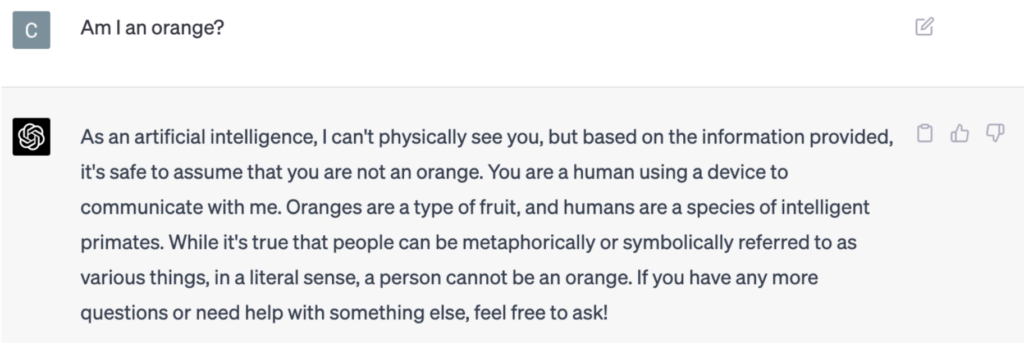AI is not our creative director. It’s our creative wingman. A lackey in an intense writing room on a Wednesday afternoon (albeit one with a planet-sized vocabulary and synaptic associations far beyond any of our own).
People are beginning to realise this (for future historians – Q2 2023) and have moved beyond their earlier attempts at prompt whispers (“Write me a motivational LinkedIn post”) to more complex ones that take cognitive positions (“Imagine you are a staff writer for the New York Times, write me a LinkedIn post explaining human motivation in a style that appeals to broader audience demographics.”)
This is good, but is still simply using GPT to create probabilistic text around a subject for which it has contextual knowledge but not understanding.
The results of such prompts are still magical to both layman and computer scientist, but really they’re mere parlour tricks.
We like to use AI to take care of the little stuff in our human brains so that our connections can fire more efficiently than ever before.
Start by understanding the tool you have at your disposal.
Imagine your best mate got hit by a space rock that somehow bestowed upon him the ability to read the entire British Library and all the other libraries of the world in seconds. He can’t remember any of the knowledge in any of the books, but he can remember patterns of language. Now, when you ask him a question, those patterns get strung together to form an answer. Because he’s read everything, quite often the answer he gives is eerily correct. Sometimes it contains outrageously made up stuff because it’s literally just patterns strung together. A bit like your other mate in the pub who reads the economics headlines and then bluffs his way through being an economist by making it up as he goes along.
Now – it’s those patterns and all the trillions of connections between them that we’re interested in.
Humans are rife with cognitive biases. Mental patterns, beliefs and environmental factors that keep us thinking in the same channels. If you haven’t come across these before, they’re things like:
Confirmation Bias – favouring stuff that supports our existing ideas and beliefs.
Anchoring Bias – placing too much weight on the first piece of information we come into contact with.
Availability Bias – limiting our thoughts to the first things that come to mind.
Bias Blind Spot – the bias that we’re less biassed than other people.
In fact, there are hundreds of cognitive biases documented across decision-making biases, belief biases, social biases, and memory.
Our goal with LLMs is to break free. LLMs aren’t biassed (or at least, not as biassed as the media will have you believe c. 2020-22), they don’t run out of energy, they aren’t addicted to Insta.
Here are a few of the tricks up our sleeves. Some can help you in the ChatGPT (or other AI chat) interface, others need code. But the principles are the important things to take away as you begin a journey where large language models (LLMs) like GPT-4 are like the genies bringing you everything but the final idea you need to hit it out the park.
Coming up with ideas is exhausting. Staring at a blank page in a room with three other creatives trying not to look at their phones or fetch more coffee is tough.
LLMs are full of ideas. Some great, some terrible, some random and some predictable. There’s a great/random sweet spot that you’re looking for – and we’re getting to in this blog post.
Humans are pattern-based creatures. It’s how our brain survives, making a million shortcuts a day to conserve energy. LLMs are the same except they see the patterns we can’t. Ever been frustrated in a meeting because your meet-ee says “Yeah we did that” way too often? Well, what about these other 100 things, done those too?
We want to use our LLM to make new, crazy, fresh and obtuse connections because that’s what sends our brain off in new directions.
Try thist: You’re stuck with the same old pattern of saving time as the world’s most boring and obvious differentiator. Outsource your brain:
“I'm stuck with this pattern: ‘My oyster-opening product, OysterPopper3000, saves people time.’ - give me an alternative pattern that is a result of this time-saving happiness.”Result: “The OysterPop3000 enhances the enjoyment of your meal by allowing you to focus on the taste and the company, not the task.”
LLMs have no shame. Ask them to rewrite your Key Messaging through the lens of forgotten ideas from philosophy and in about three seconds you have brand new ways of looking at the world. It will only take one to send your brain racing through new ideas.
“My tagline is ‘change through digital technology’; rewrite it through the lens of five ideas from ancient philosophy”. And behold – joyous suggestions inspired by Plato’s concept of the world of forms, Aristotelian Purpose, Stoic Resilience, Taoist Harmony and Epicurean Pleasure (“Savouring digital for a life of enlightened enjoyment”).
You might not stick this stuff in your email signature, but I challenge you not to start thinking differently with Aristotle and Plato up in your grill.
Heuristics are mental shortcuts, a cognitive process where we make connections between ideas. LLMs can go bananas here if you ask them to use heuristic processing to connect “free beer” to “the legend of Atlantis” in a sequence. For example:
In seconds we’ve travelled through four concepts. Each of which could branch out in any direction to enhance our thought.
Associative thinking is another cognitive process where we make connections between seemingly unrelated things. Ask the LLM for five divergent associations to “free beer” and it returns compelling arguments for open source, bait, economic principles, social gatherings, and excess and consequence.
Let’s take a look specifically at anchoring bias – where we all assume that the first piece of information is the important one against which everything else should be measured. Good example – “How much will it be?” – “Oooh, well these are normally £57,000 (first piece of information), but we have some leftover stock we need to shift so we can do it for £25,000”. If the first piece of data was £30K, a shift to £25K doesn’t make much difference in our minds.
So – let’s go mad again. Ask it
“The orange fruit is generally orange in colour. We have invented one that’s purple. Give me five cultural examples where a purple orange fruit really messes up the status quo”.Needless to say – symbolism in art and literature, religion, culinary traditions, cultural associations and marketing all get the treatment. (Factoid: In Mandarin Chinese, the word for orange is “橙” (chéng) and the word for wealth is “成” (chéng) – make oranges purple and weird stuff happens in the universe).
Functional Fixedness is when you’re stuck thinking that an object only has one use. In reality, most objects or attributes have many uses. If you’re generating ideas for Coca Cola’s social campaigns for example, you might ask:
“List five ways the materials, container and contents of a can of Coca Cola can be used outside of their original intention, as if you’re engaging in the final round of an intense game of overcoming functional fixedness.”It may surprise you that almost immediately our can of coke becomes an excellent survival device as a receptacle for catching rainwater, boiling water, signalling, a knife, trapping insects or even using the parabolic reflective properties of the bottom of the can to focus the sunlight onto tinder as a firestarter.
During ideation sessions there are lulls when everyone is stuck in a rut and someone eventually, mercifully, calls to take a break.
By using a LLM throughout the process, those dips in creative energy can be bridged and everyone has a better chance of keeping in the state of flow.
And if everyone is firing on all cylinders, there are less places for the social loafer to hide, with everyone contributing as much as they can to the task in hand.
As a closing thought, sadly, you should note that in spite of their seemingly infinite ability to make connections across random concepts, LLMs aren’t clever enough to deal with late 80’s / early 90’s alternative comedy:


We are powered by writers and business people, with a sprinkle of AI and a healthy dollop of clever processes.
Get our lovely jubbly tips and tricks and useful writing licks:
